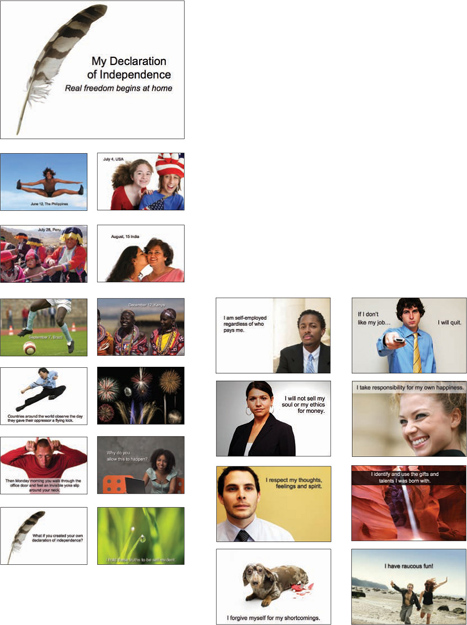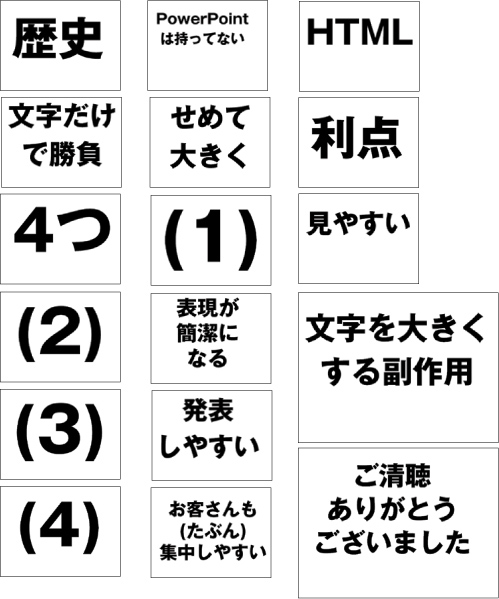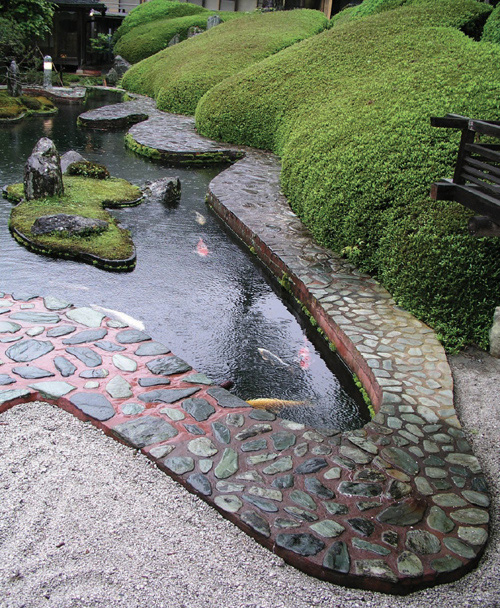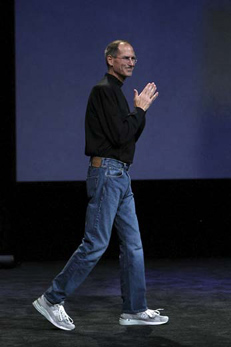Presentation Zen: Simple Ideas on Presentation Design and Delivery, 2nd Edition (Ira Katz's Library) (28 page)
Authors: Garr Reynolds

Pam Slim
Speaker, Coach, Business Consultant
www.escapefromcubiclenation.com
The few slides shown here are from a longer presentation called “My Declaration of Independence.” Pam Slim and her team designed these slides for use in both live presentations and an inspirational piece done in Flash and set to music that is on her website. For the live talk, Pam can remove more of the text so the slides complement her words.
You can watch the Flash version of this presentation on Pam’s corporate site, Ganas Consulting:

Masayoshi Takahashi
Web Application Developer, Tokyo, Japan
www.rubycolor.org/takahashi/
www.slideshare.net/takahashim
Masayoshi Takahashi is a programmer who created a new approach to presenting at tech conferences in Japan. Takahashi uses only text in his slides. But not just any text—really big text. Huge text. Characters of impressive proportion which rarely number more than a few per slide. The goal, he says, is to use short words rather than long, complicated words and phrases. His approach—now called the Takahashi Method—came about several years ago when he had to give a short presentation at a conference in Japan. He did not have software like PowerPoint, he says, nor did he have access to photos or drawing programs. He was stuck with text (projected in a Web browser). So he started thinking very hard about how to use the best word for each slide as he took the audience through his presentation. The words or phrases resemble Japanese newspaper headlines rather than sentences that must be read. His slides, though they are all text, are visual in the sense that (if you read Japanese) they are instantly understood and support his talk. As he says, if you have bullets or sentences, the audience will read those and may miss what you are saying.
While it may not be a perfect method or applicable in all situations, it is still far better than the method used by many conference presenters in Japan (dull, bulleted talking points projected on a screen).
The slides Takahashi uses in his presentations are displayed at a rapid pace and number well over a hundred per talk. The samples here are just a few from a live presentation where he explained the origins of his “Takahashi Method.” Check out his Slideshare link above to see more samples.


Merlin Mann
Productivity Guru and Creator of 43 folders
www.43folders.com
www.merlinmann.com
The slides shown here are part of a talk Merlin Mann gave in the summer of 2007 at Google’s Tech Talk series. The presentation was about strategies for dealing with high-volume e-mail and the importance of getting your inbox to zero. These simple slides—created with images from iStockphoto.com—served as a good supportive backdrop for his story. You can find a video of Merlin’s “Inbox Zero” presentation on YouTube.

A good visual enhances the speaker’s message. The sample slides featured here highlight what’s possible when you combine images and text. From a technical point of view, these slides were not too difficult to produce. All the designer needed was PowerPoint or Keynote along with image editing software such as Adobe Photoshop Elements. What you design your slides or other visuals to look like depends completely on your unique situation, content, and audience, but keep the following in mind:
• Create visuals that are simple and feature clear design priorities and elements that guide the viewer’s eye.
• Use a visual theme, but avoid tired, overused software templates.
• Limit bullet points or avoid them completely.
• Use high-quality graphics.
• Build (animate) complex graphics to support your narrative.
• Think “maximum effect with minimum means.”
• Learn to see empty space, and learn to use it in a way that brings greater clarity to visuals.


Be here now. Be someplace else later.
Is that so complicated?
—David Bader

We are offended when we try to have a conversation or a meeting with someone who seems preoccupied—someone who is not fully “there,” listening and contributing. Yet we have become quite accustomed to enduring speakers and presenters who are not fully engaged with the audience and the topic. One of the most important things to remember when delivering a presentation is to be fully present at that moment. A good presenter is fully committed to the moment, committed to being there with the audience at that particular place and time. He may have pressing problems—who doesn’t?—but he puts those aside so that he may be fully there. When you give a presentation, your mind should not be racing with a million concerns, distracted from the here and now. It is impossible to have a real conversation with someone when he is “somewhere else.” Likewise, it is impossible to give a truly successful presentation when you are “somewhere else.”
One of the most fundamental things you can learn from the world of Zen is the art of mindfulness. You may know of mindfulness in its association with meditation (
zazen
). But the interesting thing about Zen is that it is not separate from the real world. That is, Zen makes no distinction between ordinary life and spiritual life. Meditation is not an escape from reality at all; in fact, even everyday routines can be methods for meditation. When you are aware that your actions and judgments are usually just automatic reactions based on a sort of running dialogue in your head, then you are free to let go of such judgments. So, rather than hating washing the dishes, you just wash the dishes. When you write a letter, you write a letter. And when you give a presentation, you give a presentation.
Mindfulness is concerned with the here and now—with having an awareness of this particular moment. You want to see this moment as it is without your ordinary filters, filters that are concerned only with the past (or future) and how things should or will be and so on. True mindfulness is accessible to all, although it is not easy to obtain. Our lives are so crazy these days with answering e-mail, sending text messages, surfing the Web, or driving late in rush hour traffic to pick up the kids while ordering dinner on a mobile phone. There are so many things on our minds and so many worries. Worries are the worst things of all because they are always about the past or about the future—two things that do not even exist in the present. In our daily lives and in our work lives, including giving presentations, we’ve got to clear our minds and be in only one place: right here.

